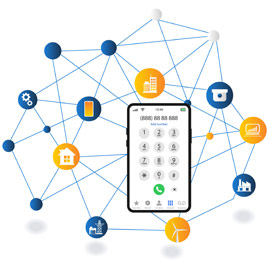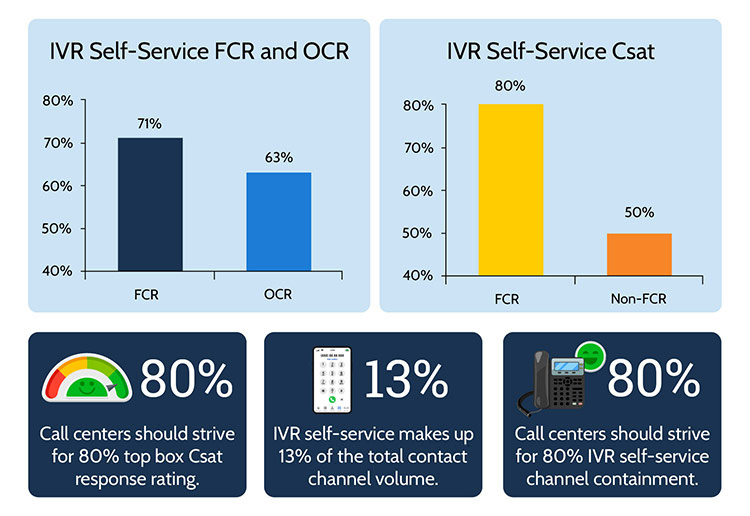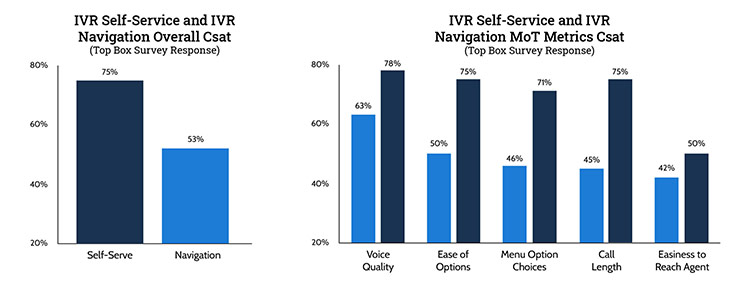IVR Dilemma
For call center leaders, the Interactive Voice Response (IVR) system creates a dilemma. On the one hand, they want the IVR system to focus on customer containment to reduce agent volume, and on the other hand, they want the IVR system to improve customer experience.
SQM's experience is that most IVR systems are designed for customer containment to reduce agent call volume and lower operating costs. Some leaders might say they want to improve IVR customer experience, but what they really want is lower operating costs. In many cases, call centers use IVR navigation roadblocks to make it difficult to reach an agent. Furthermore, in most cases, call complexity, customer channel choice, channel continuity, new, long-term, or high-value customers considerations are not used in the IVR design.
We believe that call centers can achieve IVR customer containment and improved customer experience using IVR systems for self-service and navigating to the right agent. In other words, have your cake and eat it too. The reason for this belief is because it's an IVR design issue versus an IVR technology issue. The IVR technology has come a long way in terms of its functionality and flexibility features. But, unfortunately, the IVR design tends to focus primarily on customer containment at the expense of customer experience (CX).

IVR Customer Experience Research
The IVR CX research is based on SQM benchmarking over 500 leading call centers on an annual basis. Our research shows that the IVR self-service channel is still highly used for resolving calls. In most cases, they are low-complexity inquiries such as confirming an order, checking an account balance, and reading meters. As shown in Figure 1, the IVR self-service channel makes up 13% of the total contact channel (e.g., web, phone, chat, email, and IVR) volume. According to Pew Research, 85% of customers have smartphones. With the use of visual IVR system development, the IVR self-service channel will continue to grow.
As we all know, there are some inadequate IVR systems, but there are also some very successful IVR self-service systems for resolving an inquiry on the first call. Our research shows that the IVR self-service First Call Resolution (FCR) rate is 74%, which is the highest FCR rate of all contact channels. One Contact Resolution rate is 63% (OCR measures if the call was resolved in one call and one contact channel).
When the customer experiences FCR using the IVR self-service, customer satisfaction (Csat) is 30% higher than non-FCR calls. Therefore, by improving IVR self-service FCR, call centers can achieve industry-standard goals of 80% IVR self-service channel containment and 80% IVR top box Csat response rating. As previously mentioned, the IVR self-service FCR and Csat ratings are higher than other contact channels. The higher IVR self-service FCR and Csat ratings are due to low complexity calls such as confirming an order, checking an account balance, and inquiry status update.
Figure 1: IVR Self-Service CX

Figure 2 shows the top box survey response IVR self-service overall Csat rating is 75%, and IVR Navigation overall Csat rating is 53%. Customers who use the IVR self-service like it much better than they like using the IVR for navigating to the right agent who can help them resolve their inquiry or problem. Put differently, the IVR self-service has high FCR, which is highly correlated to Csat, versus customers view the IVR navigation as an obstacle and are dissatisfied.
Furthermore, customers like the IVR self-service more than the IVR navigation because of the IVR moments of truth (i.e., voice quality, ease of use for options, menu choices, call length, and easiness to reach an agent) Csat ratings are substantially higher on all metrics than for the IVR navigation Csat ratings.
Easiness to reach the right agent moment of truth (MoT) has the lowest level of Csat of all the MoT for IVR self-service and IVR navigation. Therefore, the real opportunity to improve CX using an IVR system is to make it easier to reach an agent.
Figure 2: IVR self-service and IVR Navigation Csat

The Top 10 Tips for Improving IVR CX
- Measure your IVR
- VoC Closed-loop Improvement Process
- Make it Easy to Reach an Agent
- 2-by-4 Menu Structure
- Clear Voice Prompts
- Low Call Complexity
- Visual IVR Self-service Functionality
- Natural Language Understanding
- Sell the Benefits of IVR
- Omni-channel CX

Measure your IVR. To determine the effectiveness of the IVR self-service, you should measure customers who do not zero out, which is viewed as customer IVR containment. However, customer containment cannot measure CX. A best practice is to have the customer determine their CX for resolving their inquiry in the IVR self-service channel. Thus, the call center should evaluate the customer's experience with an outbound IVR, email, or phone survey when measuring IVR CX. The customer survey should ask the following questions:

VoC Closed-loop Improvement Process. A VoC closed-loop process identifies IVR service gaps by capturing customer survey feedback and ends with actioning customer feedback. What is essential is that IVR design and technology improvements needed are verified by the customer that they improved their customer journey for IVR self-service or IVR navigation. At SQM, our customer service management software has a VoC closed-loop feature that consists of four steps – Identify, Develop, Check, and Act (IDCA) to improve IVR CX performance.

Make it Easy to Reach an Agent. One of the biggest areas of customer dissatisfaction when using the IVR self-service channel is not having the option to zero out to reach an agent. The primary purpose of IVR self-service is for customers to be able to resolve low-complexity call types. If customers zero out for low-complexity calls, there is a fundamental problem with the design of the IVR self-service channel. The IVR self-service should give customers the zero-out option to speak with an agent at any time with a simple touch of the star (*) or the zero button. Let customers know at the beginning of the call about the star or zero-out options to reach an agent. If voice recognition is used, a customer should be able to get an agent at any time during the call just by using words such as, "I want to speak to an agent."

2-by-4 Menu Structure. Another big area of customer dissatisfaction is too many menu layers and options. It can be difficult for a customer to remember the options that are presented to them. SQM considers a 2-by-4 menu structure to be a best practice. This means that the IVR structure is two menu layers and, within each menu layer, there are only four options offered to a customer. If there are too many menu layers or options, many customers will give up and zero out. It is not uncommon for an IVR self-service menu to have 40 or more options, with many of those options seldom being used. The most popular menu options should be the first options provided to a customer. In addition, customers should be able to barge through the menu, so they do not have to listen to all the menu options.

Clear Voice Prompts. A common customer complaint with using the IVR is unclear voice prompts, resulting in the customer not understanding how to navigate the menu system. IVR scripts must be easy to understand, speak at a pace everybody can understand, use positive language, avoid organizational jargon, and use natural-sounding voice talent for the voice prompts. The IVR self-service scripts should be as one speaks in a normal conversation. Using plain language that most customers can clearly understand is critical to resolving an inquiry through the IVR self-service channel or IVR voice menu navigation to reach an agent.

Low Call Complexity. For the IVR self-service channel to successfully resolve an inquiry or problem, the first step is to determine the appropriate call types this channel should handle. For the IVR self-service channel to successfully resolve calls, it must be implemented with the right call types, not necessarily all call types. Organizations need to recognize that complex calls are better suited for the call center or email channels. Customers will use IVR self-service if it is easy to use and successful at resolving their inquiry. Therefore, the IVR self-service channel needs to be designed and maintained for resolving low-complexity inquiries. Simply implementing IVR self-service, or increasing its functionality to handle more call types, will not result in customer channel containment.

Visual IVR Self-service Functionality. A new IVR self-service operating practice is the development of visual IVR. Visual IVR self-service is a functionality infographic practice used in smartphones. The emergence of visual IVR should increase IVR self-service usage, especially when you consider that 85% of customers have a smartphone. For the visual IVR functionality, the menu options are displayed on a smartphone. This way, the customer not only hears the traditional IVR voice menu options but can also see the menu options. Therefore, the visual IVR functionality practice makes it easier for customers to choose the right menu options to resolve their inquiries or problem.

Natural Language Understanding. Many call centers use natural language understanding (NLU). The main advantage of NLU is that this technology can eliminate or reduce the customer's need to use an IVR menu. The NLU practice prompts the customer to provide an open-ended response instead of offering the customer-specific menu options. Using NLU can expand the number of menu options (100 plus) available to a customer. Also, NLU allows the customer to use natural language with an open dialog to resolve their inquiry. The NLU practice, in many cases, has been more successful than the traditional touch-tone IVR self-service operating practice for channel containment.

Sell the Benefits of IVR. Given that using the IVR system has a negative connotation for some customers, the menu options should highlight the benefits of using the IVR self-service channel for resolving their inquiries. For example, instead of the IVR menu option saying, "For insurance payment, press 1", the IVR menu option can say, "For the quickest and easiest way to pay your insurance bill, press 1". This approach will get more customers to want to use the IVR self-service channel. In addition, let customers know they can use IVR self-service at any time, 24/7, or that they can avoid waiting in the queue for an agent by using IVR self-service. The key is not to assume that customers know the benefits of the IVR self-service channel for resolving their inquiries.

Omni-channel CX. In the event that a customer chooses to be transferred to an agent, the agent should be able to view all of the customer's IVR actions on the first screen at their desktop. This way, customer frustration, and dissatisfaction can be avoided because customers do not have to repeat themselves and experience a seamless transition from the IVR to the agent. Too many organizations have their IVR systems ask the customer for authentication information only to be asked again when talking to an agent. Keeping track of customer IVR self-service actions taken (e.g., information entered or menu options chosen) and allowing agents to view this information makes it easier for both the customer and the agent when resolving the customer's inquiry. For example, if the agent starts the call by saying, "I see you used the IVR for handling the following inquiry…," rather than, "How may I help you today?", then the customer would feel it was a seamless experience for resolving their inquiry or problem. It has been SQM's experience that very few organizations provide an omni-channel experience when the IVR self-service channel is one of the channels used to resolve the same inquiry or problem.
Quick Related Links
First Call Resolution Definition First Call Resolution PPT First Call Resolution Benefits
First Call Resolution Strategies First Call Resolution Operating Philosophy FCR Case Study Survey Data Calculate First Call Resolution Rate What is a good FCR Rate? CX Pulse Check VoC Closed-loop Call Handling FCR Strategy Options Outside-In or Inside-Out
